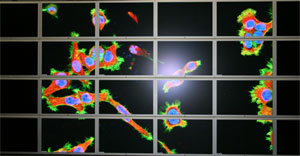NSF Funds Visualization Project at UC Irvine
Irvine, Calif., June 21, 2005 – Imagine viewing cancerous cells in full color on a wall-sized display. The nuclei, mitochondria and cell membranes are clearly visible, as are other microscopic cell components. Researchers around the world investigating various protocols can clearly track the cells’ reactions to different treatments and the progress of the disease.
|
This scenario is becoming reality. The National Science Foundation has funded a project at UC Irvine’s Center of GRAVITY (Graphics, Visualization and Imaging Technology) that will provide unprecedented high-capacity visualization capability to researchers.
The Highly Interactive Parallelized Display Wall (HIPerWall), funded with a $393,533 NSF grant, will be a massively tiled, grid-based display that allows researchers to view and manipulate their data sets at extremely high resolutions, more than 10 times that of most other tiled displays.
Because it utilizes advanced distributed computing and rendering techniques, HIPerWall requires a fraction of the cost and physical space necessary for projection-based systems.
Construction of the HIPerWall system is underway in the Calit2 Building at UC Irvine. When complete, HIPerWall will consist of 55 flat-panel displays that can be reconfigured to provide different levels of tiling and display orientations. Researchers will be able to view multiple independent data streams or 3D models from different sources at the same time, or a single full-screen visual at over 100-megapixel resolution. The system will provide crisp visual information, even in poor lighting conditions.
The resolution of HIPerWall will be close to the perception threshold of the human eye, allowing multiple users to explore information at the highest levels of resolution. Combining 3D modeling and visualization technology, and supported by middleware that will transport the data, the system one day will allow geographically separated researchers to collaboratively work on complex experiments and analyze large amounts of visual and numerical data.
“HIPerWall will enable high-impact research by linking scientists from diverse research areas and supporting fundamental research in distributed computing and visualization,” said Falko Kuester, assistant professor of electrical engineering and computer science, and one of the system’s architects. “It also promotes unique education, outreach and technology-transfer opportunities that will enhance the experience of students, helps recruit top graduate and undergraduate student researchers, and encourages industry interactions not currently possible,” added Kuester.
The system’s visualization cluster is an essential component. While the infrastructure uses readily available commodity hardware, the data handling and distributed visualization capabilities go well beyond current practice. Controlled by a cluster of 55 visualization servers with interconnected high-end graphics cards, HIPerWall will not only display data locally, but will process, display and distribute experiments across the country and around the world, leveraging supercomputer technology available through Calit2’s San Diego-based OptIPuter.
One of HIPerWall’s primary focuses is visualization of Earth science data. Researchers investigate large areas of the planet at high resolution and depth, resulting in enormous amounts of data. HIPerWall will allow researchers to see concurrently both the broad view and fine details of the data, enabling collaboration and shared viewing of complex results. A visualization cluster of high-performance commodity computers will transfer and manipulate the data to generate the 55 display signals that drive HIPerWall.
The system will be integrated with UCI’s Earth System Modeling Facility, a high-performance IBM supercomputer/storage system that allows scientists to make predictions about the planet’s physical climate, chemistry and biogeochemical cycles.
“Progress on fundamental Earth system science questions of weather, climate and the planet’s future depends on distilling meaningful insights from the largest structured datasets ever created,” said Charlie Zender, assistant professor of Earth system science.
“Whether it’s analyzing and/or comparing climate simulations and satellite observations, HIPerWall’s immense visual real estate will help researchers isolate interesting climate features across scales. Soon we will be able to simultaneously examine the interaction of slow ocean respiration and the fast regional dust storms which fertilize those oceans.”
HIPerWall also will provide visualization capabilities to a range of multidisciplinary projects, including those in physics, structural engineering, and theoretical and experimental biomedical engineering. HIPerWall is expected to foster collaboration between researchers in diverse disciplines by bringing them together and facilitating visualization of complex data from simulations.
"In addition to the unprecedented display real estate, HIPerWall provides a great platform to investigate and develop data management techniques to move data to, from and within the computing and graphics clusters,” said Stephen Jenks, assistant professor of electrical engineering and computer science, and another of the system’s architects. “Responsiveness and programmability are key goals for our infrastructure development.”
Project Webpage: http://gravity.calit2.uci.edu/projects/hiperwall
Researchers:
Falko Kuester, http://gravity.calit2.uci.edu/~fkuester;
Stephen Jenks, http://spds.ece.uci.edu/~sjenks/;
Charlie Zender, http://www.ess.uci.edu/~zender.
About Calit2: The California Institute for Telecommunications and Information Technology (www.calit2.net) integrates multidisciplinary intellectual capital and industry expertise to conduct cutting-edge research. More than 130 leading California computer, telecommunications, software and applications companies partner with Calit2 faculty participants to investigate areas as diverse as transportation, emergency response, public safety, the environment, security, health care, business, education, the arts and entertainment.
About the University of California, Irvine: Celebrating 40 years of innovation, the University of California, Irvine is a top-ranked public university dedicated to research, scholarship and community service. Founded in 1965, UCI is among the fastest-growing University of California campuses, with more than 24,000 undergraduate and graduate students and about 1,400 faculty members. The second-largest employer in dynamic Orange County , UCI contributes an annual economic impact of $3 billion.
Media Contacts
Anna Lynn Spitzer, (949) 824-3317, aspitzer@uci.edu

